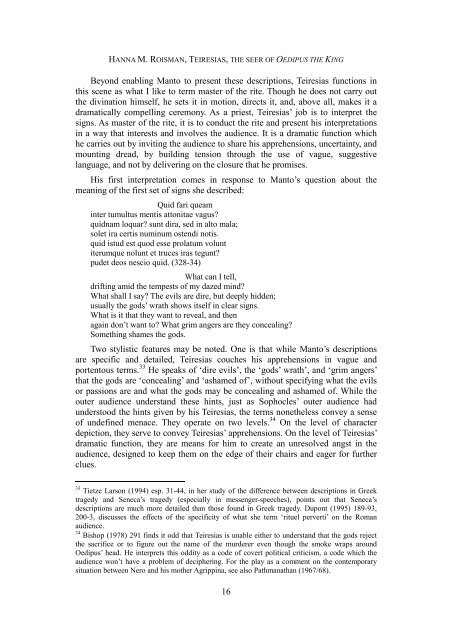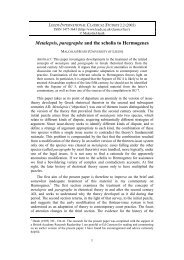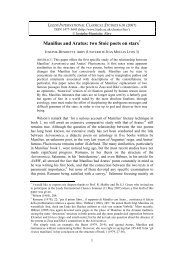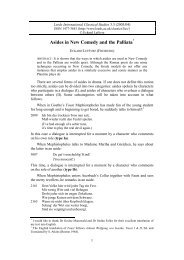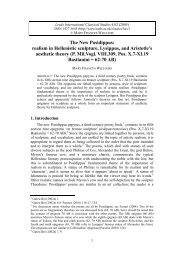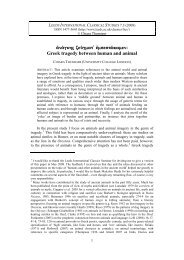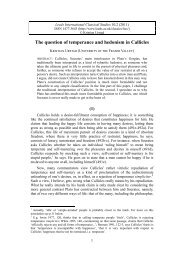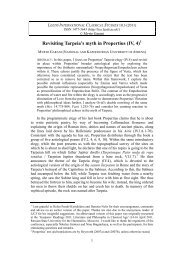Teiresias, the seer of Oedipus the King - Leeds International ...
Teiresias, the seer of Oedipus the King - Leeds International ...
Teiresias, the seer of Oedipus the King - Leeds International ...
Create successful ePaper yourself
Turn your PDF publications into a flip-book with our unique Google optimized e-Paper software.
HANNA M. ROISMAN, TEIRESIAS, THE SEER OF OEDIPUS THE KING<br />
Beyond enabling Manto to present <strong>the</strong>se descriptions, <strong>Teiresias</strong> functions in<br />
this scene as what I like to term master <strong>of</strong> <strong>the</strong> rite. Though he does not carry out<br />
<strong>the</strong> divination himself, he sets it in motion, directs it, and, above all, makes it a<br />
dramatically compelling ceremony. As a priest, <strong>Teiresias</strong>’ job is to interpret <strong>the</strong><br />
signs. As master <strong>of</strong> <strong>the</strong> rite, it is to conduct <strong>the</strong> rite and present his interpretations<br />
in a way that interests and involves <strong>the</strong> audience. It is a dramatic function which<br />
he carries out by inviting <strong>the</strong> audience to share his apprehensions, uncertainty, and<br />
mounting dread, by building tension through <strong>the</strong> use <strong>of</strong> vague, suggestive<br />
language, and not by delivering on <strong>the</strong> closure that he promises.<br />
His first interpretation comes in response to Manto’s question about <strong>the</strong><br />
meaning <strong>of</strong> <strong>the</strong> first set <strong>of</strong> signs she described:<br />
Quid fari queam<br />
inter tumultus mentis attonitae vagus?<br />
quidnam loquar? sunt dira, sed in alto mala;<br />
solet ira certis numinum ostendi notis.<br />
quid istud est quod esse prolatum volunt<br />
iterumque nolunt et truces iras tegunt?<br />
pudet deos nescio quid. (328-34)<br />
What can I tell,<br />
drifting amid <strong>the</strong> tempests <strong>of</strong> my dazed mind?<br />
What shall I say? The evils are dire, but deeply hidden;<br />
usually <strong>the</strong> gods’ wrath shows itself in clear signs.<br />
What is it that <strong>the</strong>y want to reveal, and <strong>the</strong>n<br />
again don’t want to? What grim angers are <strong>the</strong>y concealing?<br />
Something shames <strong>the</strong> gods.<br />
Two stylistic features may be noted. One is that while Manto’s descriptions<br />
are specific and detailed, <strong>Teiresias</strong> couches his apprehensions in vague and<br />
portentous terms. 33 He speaks <strong>of</strong> ‘dire evils’, <strong>the</strong> ‘gods’ wrath’, and ‘grim angers’<br />
that <strong>the</strong> gods are ‘concealing’ and ‘ashamed <strong>of</strong>’, without specifying what <strong>the</strong> evils<br />
or passions are and what <strong>the</strong> gods may be concealing and ashamed <strong>of</strong>. While <strong>the</strong><br />
outer audience understand <strong>the</strong>se hints, just as Sophocles’ outer audience had<br />
understood <strong>the</strong> hints given by his <strong>Teiresias</strong>, <strong>the</strong> terms none<strong>the</strong>less convey a sense<br />
<strong>of</strong> undefined menace. They operate on two levels. 34 On <strong>the</strong> level <strong>of</strong> character<br />
depiction, <strong>the</strong>y serve to convey <strong>Teiresias</strong>’ apprehensions. On <strong>the</strong> level <strong>of</strong> <strong>Teiresias</strong>’<br />
dramatic function, <strong>the</strong>y are means for him to create an unresolved angst in <strong>the</strong><br />
audience, designed to keep <strong>the</strong>m on <strong>the</strong> edge <strong>of</strong> <strong>the</strong>ir chairs and eager for fur<strong>the</strong>r<br />
clues.<br />
33 Tietze Larson (1994) esp. 31-44, in her study <strong>of</strong> <strong>the</strong> difference between descriptions in Greek<br />
tragedy and Seneca’s tragedy (especially in messenger-speeches), points out that Seneca’s<br />
descriptions are much more detailed than those found in Greek tragedy. Dupont (1995) 189-93,<br />
200-3, discusses <strong>the</strong> effects <strong>of</strong> <strong>the</strong> specificity <strong>of</strong> what she term ‘rituel perverti’ on <strong>the</strong> Roman<br />
audience.<br />
34 Bishop (1978) 291 finds it odd that <strong>Teiresias</strong> is unable ei<strong>the</strong>r to understand that <strong>the</strong> gods reject<br />
<strong>the</strong> sacrifice or to figure out <strong>the</strong> name <strong>of</strong> <strong>the</strong> murderer even though <strong>the</strong> smoke wraps around<br />
<strong>Oedipus</strong>’ head. He interprets this oddity as a code <strong>of</strong> covert political criticism, a code which <strong>the</strong><br />
audience won’t have a problem <strong>of</strong> deciphering. For <strong>the</strong> play as a comment on <strong>the</strong> contemporary<br />
situation between Nero and his mo<strong>the</strong>r Agrippina, see also Pathmanathan (1967/68).<br />
16


